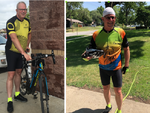Since 1982 I have been riding Campy Record/Shimano DuraAce-equipped road bikes - Pinarello SL, DeRosa SLX, Litespeed Classic, Colnago MasterLight. All are quick, light and a joy to ride, and the workmanship of the frames and components are impeccable. Life was good until a few years ago when my knees began to bother me, especially after riding, and I was no longer able to pound the pedals as I once did. After some research, I decided to get a 2018 Giant Road E+ (USA model, 5 power levels, 28 mph E support). I've been riding it for over a month now and here are some thoughts, pro and con, and a couple of questions. I typically ride 20-25 miles/day over hilly terrain comprising short (¼-½ mile) steep inclines, longer (1-2 mile), gentle hills and flats along the ocean which often means strong, onshore winds.,
PROS: a) The Road E+ is a pleasure to ride but with some reservations. Knee issues are a thing of the past, and I can always find a gear/power level that can still give me a workout. My average speed on my old bikes was typically 12-13 mph; I can now maintain 19-20 mph at the same heart rate but with no knee issues. The only point I need address is that a formerly 2 hr ride not takes only 1.5 hr, so I need to increase the length of my ride to get the same exercise benefit.
b) The torque sensor does it job perfectly. When I push harder on the pedals, the power assist increases, so I can maintain speed with less effort.
c) I typically ride on the larger chain ring and the three or so smallest rear cogs, increasing the power, rather than downshifting, as needed. Usually, I ride in Eco or Eco+, sometimes Normal, and rarely Sport or Sport+ and then only on steep hills or against strong winds. I have yet to use the smaller chain wheel, and I cannot fathom why Giant put a 34 tooth cog in the back. In contrast, on my other road bikes I would normally stay on the smaller 39T chainwheel and shift up and down the 12-24T cassette, using the 53T chainwheel for downhill descent or with strong tailwinds.
d) I'm guessing I would have a 100 mile range if I were to ride only in Eco mode. Not bad at all.
CONS: a) Take away the E-releated gear on the bike, and you have a fairly standard, mid-range, aluminum frame bike with mid-level components, something Giant might sell for maybe $1500, but also with a very long wheelbase. Throw in 25 lbs of batteries/motor/etc. and you have a bike that is simply not quick nor responsive nor nimble in any way. I would throw in"sluggish" but the motor takes care of that problem. Still, the bike is a joy to ride, and the lack of spryness is overcome by its effortless pedaling.
b) There was a learning curve on how to ride and smoothly shift gears which I still haven't mastered. The bike encourages you to shift into lower gears than you might otherwise choose to do in order to get greater assist. This is OK, and you get used to it, but here's a problem I'd like some feedback on. On a standard road bike, you always want to be pedaling while shifting for a smooth shift. The opposite is true on the Road E+, at least in my experience. If I don't STOP pedaling when I shift, the rear derailleur crunches and grinds the gears, a problem that gets worse at higher power levels. I've gotten used to this, so when I want to shift, I stop pedaling for a ¼-½ revolution, shift, and then resume pedaling. Problem gone, but I wonder if the grinding/crunching gears I've expereinced is normal, or a defect on my bike. Please let me know your experience.
c) I'm having a problem with condensation on the inside surface on the control unit, usually in the first 15-20 of riding when the sun hits the unit. This disappears after another 10-15 of riding. Strangely, the condensation isn't across the entire interior surface but in an area of about 1x5 cm. It's as if there was an invisible smear that attracts moisture which later evaporates. Anyone else have a similar condensation problem?
d) The weight, the weight, the weight. Not a complaint really. I get where it all comes from and why it's needed, but maneuvering the bike while walking, especially if on a hill or encountering a curb or steps is a real challenge.
SUMMARY: For me the Road E+ solved what would otherwise have been an insurmountable problem. I've been riding all my life and can't imagine not being able to continue. However, age and biology do take their toll on one's joints and, to some extent, stamina. The solution is to either give up the riding and something you love, or do what you gotta do to keep riding, benefit from the exercise and experience the joy of being on the road. The Road E+ allows me to do this. Well done, Giant.
PROS: a) The Road E+ is a pleasure to ride but with some reservations. Knee issues are a thing of the past, and I can always find a gear/power level that can still give me a workout. My average speed on my old bikes was typically 12-13 mph; I can now maintain 19-20 mph at the same heart rate but with no knee issues. The only point I need address is that a formerly 2 hr ride not takes only 1.5 hr, so I need to increase the length of my ride to get the same exercise benefit.
b) The torque sensor does it job perfectly. When I push harder on the pedals, the power assist increases, so I can maintain speed with less effort.
c) I typically ride on the larger chain ring and the three or so smallest rear cogs, increasing the power, rather than downshifting, as needed. Usually, I ride in Eco or Eco+, sometimes Normal, and rarely Sport or Sport+ and then only on steep hills or against strong winds. I have yet to use the smaller chain wheel, and I cannot fathom why Giant put a 34 tooth cog in the back. In contrast, on my other road bikes I would normally stay on the smaller 39T chainwheel and shift up and down the 12-24T cassette, using the 53T chainwheel for downhill descent or with strong tailwinds.
d) I'm guessing I would have a 100 mile range if I were to ride only in Eco mode. Not bad at all.
CONS: a) Take away the E-releated gear on the bike, and you have a fairly standard, mid-range, aluminum frame bike with mid-level components, something Giant might sell for maybe $1500, but also with a very long wheelbase. Throw in 25 lbs of batteries/motor/etc. and you have a bike that is simply not quick nor responsive nor nimble in any way. I would throw in"sluggish" but the motor takes care of that problem. Still, the bike is a joy to ride, and the lack of spryness is overcome by its effortless pedaling.
b) There was a learning curve on how to ride and smoothly shift gears which I still haven't mastered. The bike encourages you to shift into lower gears than you might otherwise choose to do in order to get greater assist. This is OK, and you get used to it, but here's a problem I'd like some feedback on. On a standard road bike, you always want to be pedaling while shifting for a smooth shift. The opposite is true on the Road E+, at least in my experience. If I don't STOP pedaling when I shift, the rear derailleur crunches and grinds the gears, a problem that gets worse at higher power levels. I've gotten used to this, so when I want to shift, I stop pedaling for a ¼-½ revolution, shift, and then resume pedaling. Problem gone, but I wonder if the grinding/crunching gears I've expereinced is normal, or a defect on my bike. Please let me know your experience.
c) I'm having a problem with condensation on the inside surface on the control unit, usually in the first 15-20 of riding when the sun hits the unit. This disappears after another 10-15 of riding. Strangely, the condensation isn't across the entire interior surface but in an area of about 1x5 cm. It's as if there was an invisible smear that attracts moisture which later evaporates. Anyone else have a similar condensation problem?
d) The weight, the weight, the weight. Not a complaint really. I get where it all comes from and why it's needed, but maneuvering the bike while walking, especially if on a hill or encountering a curb or steps is a real challenge.
SUMMARY: For me the Road E+ solved what would otherwise have been an insurmountable problem. I've been riding all my life and can't imagine not being able to continue. However, age and biology do take their toll on one's joints and, to some extent, stamina. The solution is to either give up the riding and something you love, or do what you gotta do to keep riding, benefit from the exercise and experience the joy of being on the road. The Road E+ allows me to do this. Well done, Giant.

